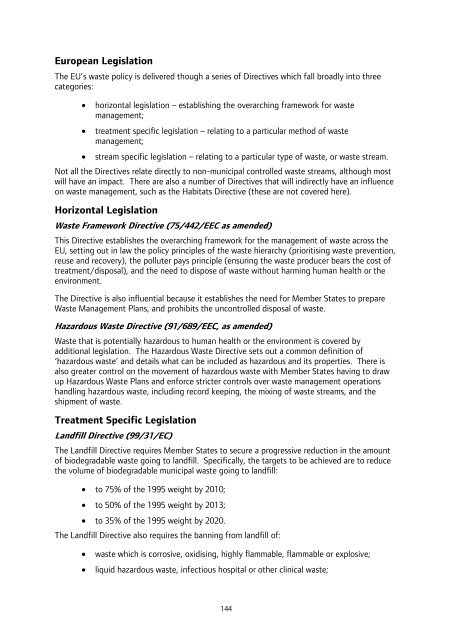London Wider Waste Strategy - London - Greater London Authority
London Wider Waste Strategy - London - Greater London Authority
London Wider Waste Strategy - London - Greater London Authority
You also want an ePaper? Increase the reach of your titles
YUMPU automatically turns print PDFs into web optimized ePapers that Google loves.
European Legislation<br />
The EU’s waste policy is delivered though a series of Directives which fall broadly into three<br />
categories:<br />
• horizontal legislation – establishing the overarching framework for waste<br />
management;<br />
• treatment specific legislation – relating to a particular method of waste<br />
management;<br />
• stream specific legislation – relating to a particular type of waste, or waste stream.<br />
Not all the Directives relate directly to non-municipal controlled waste streams, although most<br />
will have an impact. There are also a number of Directives that will indirectly have an influence<br />
on waste management, such as the Habitats Directive (these are not covered here).<br />
Horizontal Legislation<br />
<strong>Waste</strong> Framework Directive (75/442/EEC as amended)<br />
This Directive establishes the overarching framework for the management of waste across the<br />
EU, setting out in law the policy principles of the waste hierarchy (prioritising waste prevention,<br />
reuse and recovery), the polluter pays principle (ensuring the waste producer bears the cost of<br />
treatment/disposal), and the need to dispose of waste without harming human health or the<br />
environment.<br />
The Directive is also influential because it establishes the need for Member States to prepare<br />
<strong>Waste</strong> Management Plans, and prohibits the uncontrolled disposal of waste.<br />
Hazardous <strong>Waste</strong> Directive (91/689/EEC, as amended)<br />
<strong>Waste</strong> that is potentially hazardous to human health or the environment is covered by<br />
additional legislation. The Hazardous <strong>Waste</strong> Directive sets out a common definition of<br />
‘hazardous waste’ and details what can be included as hazardous and its properties. There is<br />
also greater control on the movement of hazardous waste with Member States having to draw<br />
up Hazardous <strong>Waste</strong> Plans and enforce stricter controls over waste management operations<br />
handling hazardous waste, including record keeping, the mixing of waste streams, and the<br />
shipment of waste.<br />
Treatment Specific Legislation<br />
Landfill Directive (99/31/EC)<br />
The Landfill Directive requires Member States to secure a progressive reduction in the amount<br />
of biodegradable waste going to landfill. Specifically, the targets to be achieved are to reduce<br />
the volume of biodegradable municipal waste going to landfill:<br />
• to 75% of the 1995 weight by 2010;<br />
• to 50% of the 1995 weight by 2013;<br />
• to 35% of the 1995 weight by 2020.<br />
The Landfill Directive also requires the banning from landfill of:<br />
• waste which is corrosive, oxidising, highly flammable, flammable or explosive;<br />
• liquid hazardous waste, infectious hospital or other clinical waste;<br />
144
















